Cube GTC Di2: First ride review
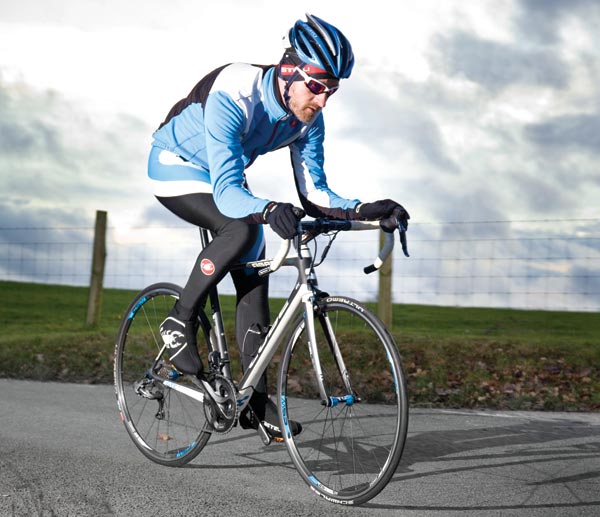
Cube GTC Di2
You can trust Cycling Weekly.

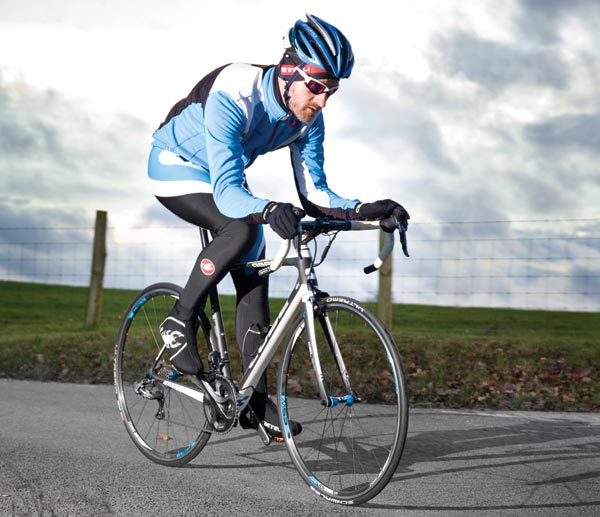
Words: Neil Webb; Photos: Chris Catchpole
Pretty much everyone has been going silly at the prospect of Shimano’s launching a ‘budget’ version of its SEIS electronic shifting system. Ultegra Di2 (we refer to it as Ui2 to differentiate it from the high-end Dura-Ace Di2) is substantially cheaper than the top-flight group Shimano launched in 2010, but claims to offer the same slick, fast shifting at the touch of a button.
We got hold of one of the first Ui2-equipped bikes in the UK; the Cube GTC is a great example of the sort of (comparatively) great-value bike we imagined we’d see when we first heard about the electronic groupset. Before exploring the benefits and performance of the shifting system, let’s consider the rest of the bike.
Sitting at the top of the table of Cube’s mid-range road bikes, the GTC Di2 is still packed full of innovation. It shares the same Twin Mould carbon construction as the range-topping Litening Super series of bikes (where internal moulds and resin are used), but also lacks some of weight-saving refinements and uses a slightly different modulus of carbon-fibre. There’s no right or wrong modulus to use for a race bike — the fibres in the GTC are more resilient and resist knocks better than the Litening Super’s Super High Modulus, but are slightly heavier. That’s not to say the GTC is a heavyweight; our 55cm model weighed in at a little over 7kg.
Slim and sleek
Visually, the frame’s silhouette is very sleek. The top tube, in particular, is very flat and wide. This keeps the front-end of the bike in line with the rear when pushing on, but also offers a little bit of vertical flex. Paired with the ultra-slimline chainstays, this helps explain why the GTC is exceptionally comfortable on rougher roads. The rest of the bike is buzz-free, thanks to quality carbon fibre and quality tyres and wheels, and the ride quality is not compromised. An oversized bottom bracket uses the latest push-fit bearing technology. Not having the material usually required for internal threads not only allows for a lighter frame, it also gives the chainstays and down tube a larger area to attach to. These large-scale connections make sure that minimal pedal input is lost to frame flex. Stamp on the pedals and the GTC shifts, fast.
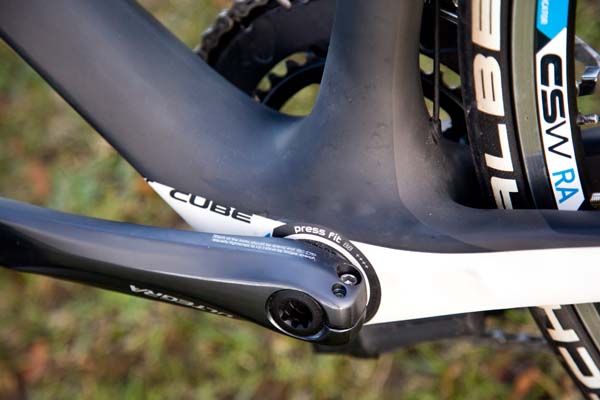
As you’d expect on a bike at this price, most parts are high-end. The Syntace bar and stem are light and flex-free, but thankfully the full-carbon fork soaks up road vibration, and even big knocks are well dulled. Your hands are free to retain control, rather than be deadened by the stiff cockpit components. Colour-coded DT Swiss wheels look great and were problem-free during our testing, but model-specific straight-pull spokes may cause a few, short-lived issues if you experience any breakages down the road.
Lower-tech brakes
The only other minor gripe we have with the spec is the brakes. The cheaper, non-series Shimanos stop well enough, and cartridge brake blocks will facilitate simple routine maintenance, but their braking power doesn’t live up to the high-tech performance of the gears. This is one area where Cube has saved money to allow the complete bike to come in at under £2.5K. Admitted, we’re splitting hairs, and a £20 brake-pad upgrade would make a big improvement, so don’t let this put you off.
As we stated, the major reason we procured the Cube was to get time on Ui2. Instead of pulling cables manually to move the derailleurs, movement is taken care of by electric motors, operated via paddles positioned where Shimano’s gear-change levers are normally. One big, unforeseen advantage is the removal of mechanical internals: the body of the brake and shifter is noticeably slimmer. It’s good for small- and shovel-handed riders alike, as the square edges that can cause pressure on a long ride are gone. The shifting itself is, frankly, incredible.
A cable-shift may not seem slow, but the fraction-of-a-second saving is noticeable and, with no cable-stretch or contamination to contend with, they stay perfectly in sync, whatever the time-frame or weather.
While the rear shifting is impressive, the biggest improvement is with the front derailleur.
The powerful motor forces the chain on to the big chainring with ease regardless of how hard you’re pedalling. Slamming the bike on to the big ring as you crest a hill to leave ride buddies for dead is more than just possible, it’s addictive — provided you have the legs! Battery-life is huge too, so isn’t a pitfall. You can expect months between charges, and there is a visible battery-life indicator. On top of that, the powerful front derailleur will stop working before the rear, so you’ll never get stuck in an unmanageable ratio if you do forget to charge it.
If we were to say we’re gutted to be going back to a cable-shifting bike when this goes back, it should tell you everything you need to know. The Cube itself is a great, fast, race ready machine, but the Ui2 is the star. Even after a short time on the system, we can’t see why anyone wouldn’t want it. The quality is great, performance excellent — and yes, it’s a step up from mechanical. You get great-quality mechanical componentry at this price, but if it were our money, we’d go electric — every time!
Cube GTC Di2: Specification
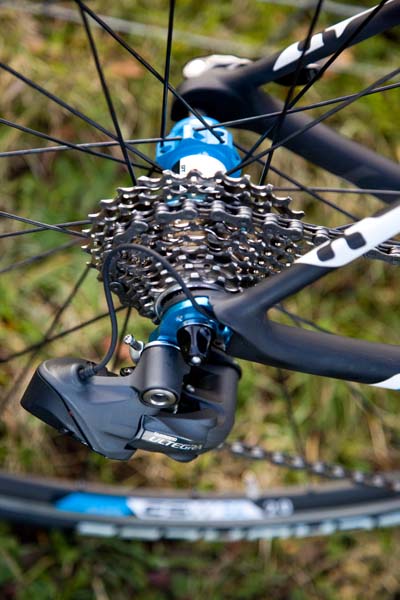
Frame
Monocoque Advance Twin Mould Technology carbon-fibre
Fork CSL Evo full carbon
Gears Shimano Ultegra Di2
Wheels DT Swiss CSW RA2.0
Tyres Schwalbe Ultremo ZX 700 x 23c
Handlebar Syntace Racelite 2014 Oversized
Stem Syntace F149 Oversized
Saddle Selle Italia X1
Seatpost Syntace R6 carbon 27.2mm
Weight 7.5kg (16.5lb) w/pedals
Frame Size tested 56cm
Colour Carbon/white/ grey
Brakes Shimano BR R-561
Brake levers and shifters Shimano Ultegra Di2
Cassette Shimano 12-27
Price £2,499.99
Contact www.cube.eu/en
Alternative
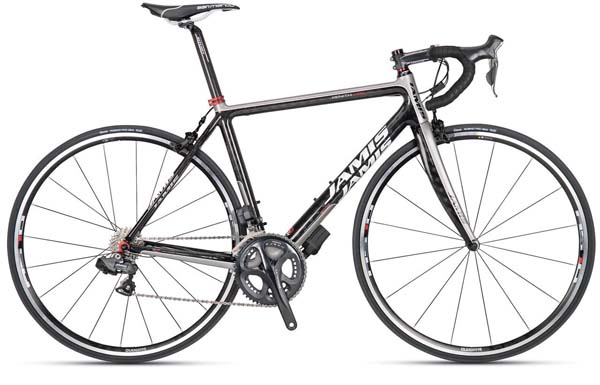
Jamis Xenith Pro Di2 £2,799.99
While many bike brands are sticking with a complete Shimano UI2 groupset, there are a few others following a similar pattern to Cube in order to offer the shifting performance at a more affordable price. The Jamis Xenith shares a similar racy shape to the Cube, and also has cheaper brakes but the benefit is in the bottom line; it still comes in at under £3,000, the point at which many manufacturers start including high-end electronics in their line-ups.

Thank you for reading 20 articles this month* Join now for unlimited access
Enjoy your first month for just £1 / $1 / €1
*Read 5 free articles per month without a subscription

Join now for unlimited access
Try first month for just £1 / $1 / €1
Get The Leadout Newsletter
The latest race content, interviews, features, reviews and expert buying guides, direct to your inbox!

Nigel Wynn worked as associate editor on CyclingWeekly.com, he worked almost single-handedly on the Cycling Weekly website in its early days. His passion for cycling, his writing and his creativity, as well as his hard work and dedication, were the original driving force behind the website’s success. Without him, CyclingWeekly.com would certainly not exist on the size and scale that it enjoys today. Nigel sadly passed away, following a brave battle with a cancer-related illness, in 2018. He was a highly valued colleague, and more importantly, an exceptional person to work with - his presence is sorely missed.
-
 'This is the marriage venue, no?': how one rider ran the whole gamut of hallucinations in a single race
'This is the marriage venue, no?': how one rider ran the whole gamut of hallucinations in a single raceKabir Rachure's first RAAM was a crazy experience in more ways than one, he tells Cycling Weekly's Going Long podcast
By James Shrubsall Published
-
 Full Tour of Britain Women route announced, taking place from North Yorkshire to Glasgow
Full Tour of Britain Women route announced, taking place from North Yorkshire to GlasgowBritish Cycling's Women's WorldTour four-stage race will take place in northern England and Scotland
By Tom Thewlis Published
-
 Positive signs for UK bike industry as Halfords cycling sales grow
Positive signs for UK bike industry as Halfords cycling sales growRetailer admits that the impact of Donald Trump's tariffs remains to be seen
By Tom Thewlis Published